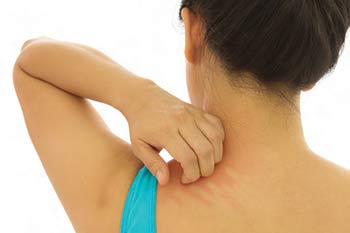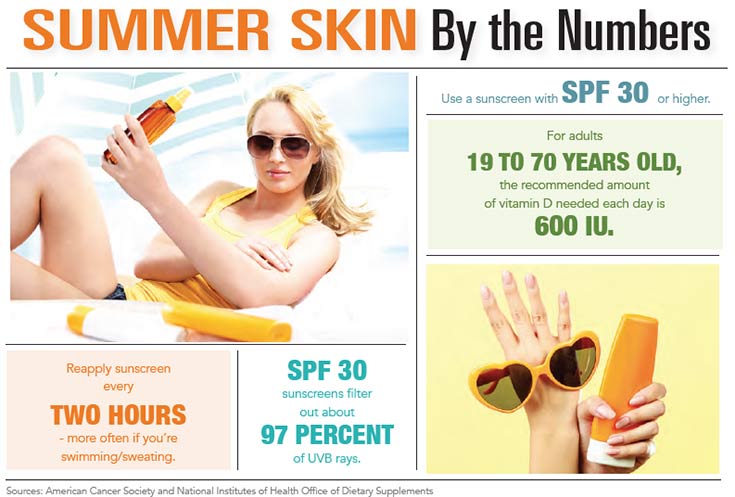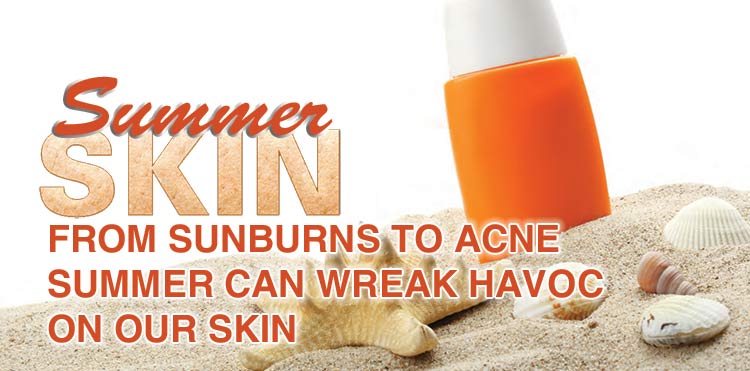Summer Skin: From Sunburns to Acne, Summer Can Wreak Havoce on Our Skin
Summertime in Charleston means playing at the beach, taking the boat out or relaxing at the neighborhood pool – anything to stay cool while enjoying a Lowcountry summer. All that time spent in the sunshine and in the water makes for a fun-filled season, but it also can lead to some irritating and potentially damaging skin issues.
Nothing ruins a day outdoors like a blistering sunburn. Showering, putting on clothing or even sitting can be excruciating when you have a bad burn. And, certainly, repeated sunburns or chronic sun exposure carry the potential to cause skin cancer.

Dr. Erin Walker with the Dermatology & Laser Center of Charleston said most people can burn within just 30 minutes of sun exposure – possibly less for those with fair skin. She recommended using a sunscreen with at least an SPF of 30 and avoiding the sun in the middle of the day. Clothing with built-in sun protection or using an umbrella when out at the beach are also good ways to block the sun’s harmful rays.
Dr. Marguerite Germain of Germain Dermatology in Mount Pleasant said it’s also important to look at the ingredients in your sunscreen. She recommended selecting ones with physical blocks such as zinc oxide and fewer chemicals.
And applying enough sunscreen is key. She suggested about one shot glass full for the body and a teaspoon for the face, neck and ears. Reapply sunscreen at least every four hours, Dr. Germain said – more frequently if you’re swimming or sweating.
SHOULD YOU LOOK TO THE SUN FOR YOUR VITAMIN D?
Vitamin D is important for building and maintaining strong bones. And while the sun can provide vitamin D, there’s a fine line in getting enough vitamin D without too much exposure to the sun.
“It is true that the active form of vitamin D is formed in our skin during sun exposure. However, you can never be sure what the right amount of sun exposure is,” said Dr. Marguerite Germain of Germain Dermatology in Mount Pleasant. “There was a study done on surfers who were out in the sun most of the day, and a significant number of them had vitamin D deficiency.”
The American Academy of Dermatology does not recommend getting vitamin D from sun exposure – either naturally outdoors or in tanning beds – because the risk for skin cancer is too great. The safest solution is to eat foods rich in vitamin D, such as fortified milk, cheese, yogurt, salmon and tuna. You also can consult with your doctor on taking a vitamin D supplement.
“Try to stay out of the sun between 10 a.m. and 5 p.m.,” she said. “Only go out when your shadow is longer than you are. If your shadow is shorter than you are, the sun is too overhead and too strong.”
It’s also important to remember the sun reflects off surfaces like water, concrete and sand, Dr. Germain said.
“You can get sun from above and below if you are on these surfaces or in a boat,” Dr. Germain pointed out.
Dr. Walker also reminded everyone to wear sunscreen on their face year-round – not just in the summer months.
“The best anti-aging thing for your skin is to use sun protection every single day,” she said.
People who have rosacea or eczema may find their conditions tend to flare up in the summer months due to the heat, as well as because of excessive sweating. And those taking particular medications need to be aware of the potential for added sun sensitivity. For example, someone on the antibiotic doxycycline – often prescribed for rosacea and severe acne – is likely to sunburn easier.
Spend one summer in Charleston and you’ll know it’s a sweaty season. Excessive perspiring can lead to skin problems like fungal infections or yeast infections, which are common in the groin area, under the arms and under the breasts.
Dr. Germain suggested seeing a doctor if a fungal condition doesn’t improve with antibacterial soap and over-the-counter fungal treatments.
Clogged pores from excess sweating also can cause acne to develop or worsen for those who already have acne-prone skin.
Tick bites, poison ivy and bites from ever-present mosquitoes can result in annoying, itchy bumps. Normally these will clear up on their own, but Dr. Walker said anyone with a severe case may be having an allergic reaction and should see a doctor.
Many of summer’s most common skin issues are annoying or itching but tend to get better with over-the-counter treatments in a few days. Dr. Walker said if symptoms persist beyond five to seven days or if they worsen significantly in a short period of time, it’s time for medical attention.
“We’re more concerned, from a dermatology standpoint, if you have something that’s changing, bleeding or not healing,” Dr. Walker said. “Our concern is always skin cancer’s signs and symptoms.”
Dr. Germain said everyone should get a full skin exam each year so a dermatologist can look for problems, and patients can report any changes in the skin.
Of all the potential summer skin issues, constant sun exposure is by far the most concerning. In fact, skin cancer is the most commonly diagnosed cancer in the United States, according to the American Cancer Society’s “Cancer Facts & Figures 2017.”
An estimated 87,110 new cases of melanoma will be diagnosed in the United States, and it’s expected to kill 9,700 people this year.
“I always tell my patients to have fun in the sun but not to lie out in the sun,” Dr. Germain said. “Of course, we want to enjoy the outdoors in the summertime and be physically active, but we just have to be sun smart about it.”
DON’T FORGET TO PROTECT YOUR EYES
We slather ourselves with sunscreen to protect our skin from the sun and then toss on cheap sunglasses that don’t do anything to protect our eyes from the sun’s powerful rays.
The eyes are one of the most sensitive sensory organs, so they need just as much protection from the sun as our skin, said optometrist Dr. Katie Davis of Draisin Vision Group in Charleston. She recommended polarized UV-blocking sunglasses as the best way to protect the eyes during a Lowcountry summer. Cheap sunglasses actually open the pupil as they shade the eyes but allow in more harmful UV rays because they do not have an appropriate UV blocker, Davis said.
Any time people are out in the sun for more than about 20 minutes, they should be wearing UV-blocking sunglasses. The back of the eyes are susceptible to damage from the sun that can lead to cancer, early cataracts or degeneration of the eye tissue, Dr. Davis said.
Often changes in eyesight are so subtle, people don’t realize they have a problem until it’s become significant. Dr. Davis urged people to have an annual eye exam and certainly to see their eye doctor if they notice any changes to the front surface of the eye, such as bumps, or yellow spots on the white part of their eye – a sign of UV damage.








